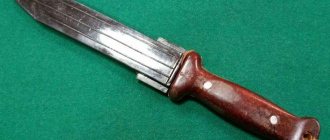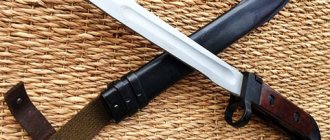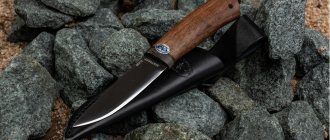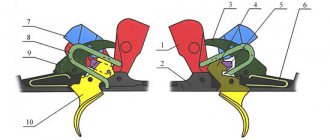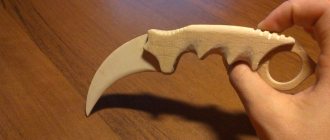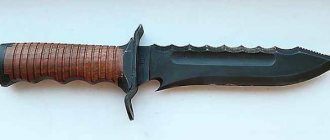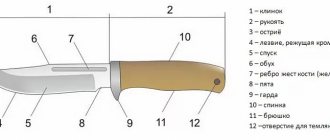Among the wide variety of knives, combat models occupy a special place. Despite the development of military technologies and weapons, a simple knife is still an effective assistant in close combat. Therefore, all the armies of the world are working to improve the characteristics of the combat knife. Despite the fact that knife designs have been studied for centuries, this area still has enormous potential for development. We are talking mainly about creating highly specialized models that could solve a specific problem as efficiently as possible. One of these knives is the Kochergin knife. Today we will get acquainted with its structure, operating principle and expert opinion regarding this model.
History of creation
Kochergin's combat knife was created purely for the hand-to-hand combat system developed by the St. Petersburg Center for Applied Research. When developing the design of this knife, the authors tried to take into account exactly the requirements for weapons that the mentioned system imposes, without taking into account any weapon trends. The first task of the designers was to find ways to achieve the maximum stopping effect of the knife by increasing its cutting ability when delivering a piercing blow. As the practice of working with weapons has shown, within the framework of the system created by the Center for Research, the thrust is the most effective way of a knife attack. Work on the development and testing of the NDK-17 model lasted seven years and led to significant results. In 2008, Kochergin’s knife, which received a very unusual shape, was presented to the public.
Kochergin's sabotage knife NDK-17: history of creation
During design developments, the authors tried to take into account as much as possible all the requirements for weapons according to the mentioned martial arts system. A search was carried out for specific constructive ways to increase the cutting ability of a knife in order to achieve the maximum stopping effect when making an injection, as a proven method of using weapons in the fighting system created by the Center. Work on the creation and testing of the special-purpose NDK-17 model lasted for seven years and led to significant results. The model was first introduced in 2008. The abbreviation of the project name contains:
- combination of words sabotage knife Kochergina;
- The initially approved blade length was 17 cm, which was reduced to 150 mm during practical experience, as providing the best balance and maneuverability of the product.
The steel grade of the original model is not disclosed, but the material successfully combines the high cutting properties of the blade and sufficient blade strength. According to the developers themselves, since high-hard steels that provide maximum cutting qualities are very fragile raw materials, it was the design solutions that made it possible to increase the cutting ability of the knife with the greatest stopping effect when pricking. As a result, a unique blade was obtained, and not a repetition of existing modifications of edged weapons.
The model bears the name of the author of the idea of its creation - Andrei Nikolaevich Kochergin. He is considered the founder of the Russian school of karate Koi no Takinoboriyu. Tanto Jutsu Koi no Takinoboriryu is a style of knife fighting in this system, the first official in Russia, according to which since 1997 sports fights have been held in accordance with approved international rules.
On the basis of this style, a domestic system was developed, using a knife specially created by Kochergin for combat - NDK-17. The peculiarity of this applied combat training system is that the combat tactics are characterized by technical brevity and lack of symmetry in contact with a knife. Based on such techniques, the TsPI team is constantly developing and implementing domestic methods for training special forces in various areas, including:
- applied hand-to-hand combat;
- fire training;
- tactical and group interaction.
The NDK-17 model is the result of the joint work of specialists from the Center for Research and Development and the VIFK. Kochergina's sabotage knife is an innovative invention. According to leading domestic and foreign experts, it is recognized as one of the most notable developments of our time in the field of edged weapons.
general characteristics
As you probably guessed, the abbreviation NDK stands for “Kochergin sabotage knife.” “17” is the original approved blade length. During practical experience, in order to improve the balance and maneuverability of the product, it was reduced to 15 cm, but they decided to leave the name the same. Many people decipher the abbreviation NDK as “Kochergin’s landing knife,” but this is not true. We figured out the name, but who is Kochergin? Andrei Nikolaevich Kochergin is a martial artist and founder of the Russian school of karate Koi no Takinoboriryu (or simply KOI).
Andrei Nikolaevich has been practicing martial arts since he was 14 years old. At first it was judo, and a little later - karate. While living in Germany, he mastered Wun Chun and Thai boxing. Returning to his homeland, Kochergin actively took up daido juku. In addition to rich experience in the field of martial arts, he also has military experience: he served in an army sports company and intelligence service, and participated in the Caucasus campaign. Kochergin is a multiple winner of shooting competitions and a master of sports in shooting with a Makarov pistol. Andrey Kochergin is known to the general public for his master classes and seminars on self-defense. He is the author of several books and a huge number of video clips devoted not only to self-defense, but also to applied psychology.
The knife fighting style operating within the KOI system is called Tanto Jutsu Koi no Takinoboriryu. It became the first official style of knife fighting in Russia, in which competitions have been held since 1997. On the basis of Tanto Jutsu Koi, a domestic knife fighting system was developed, specifically for which the NDK-17 knife (saboteur knife designed by Kochergin) was created.
The peculiarity of this applied system is that combat tactics are based on technical brevity and the lack of symmetry in contact with edged weapons. Guided by this principle, the TsPI team is continuously developing and implementing domestic methods for training special units in several areas:
- Applied hand-to-hand combat.
- Fire training.
- Group and tactical interaction.
Kochergin's knife (NDK-17) is the result of joint developments by the Central Research Institute and VIFK (Military Institute of Physical Culture). This product is an innovative invention. Reviews from many domestic and foreign experts show that it is one of the most striking modern developments in the field of edged weapons.
The developers do not disclose the grade of steel from which the original model is made. It is only known that the material successfully combines high blade strength and good cutting properties. High-hardness steels, which provide maximum cutting effect, are quite brittle materials. According to the creators of this knife, they were able to achieve high cutting ability thanks to the introduction of an unusual design. As a result, a unique blade was created, which has no analogues in the world.
Main structural elements
The structure of the NDK 17 knife.
The knife is made in the shape of a “straightened sickle”, due to which the blade has acquired additional functionality. Cutting pressure parameters have increased significantly compared to models with a straight blade. From the first cut, the tested sample cut through the chest of a 620 mm thick pork carcass, even damaging the ribs.
Leather sheaths are ideal for various types of equipment. The weapon lies tightly in them and does not make any noise when moving. Can be easily removed from its sheath at any time.
Epoxy blackening is used to coat the blade, which prevents corrosion on the metal and helps in camouflaging the weapon.
Requirements for combat knives
The main task facing a person using a combat knife is to hit an enemy or opponents in close combat. As expert reviews show, a professional with the proper level of training can use almost any tool in combat. However, maximum effectiveness is achieved with the help of special weapons designed purely for close combat techniques. Based on this, a combat or sabotage knife must combine the following characteristics:
- The blade width is at least 2 cm. At the same time, by reducing the sharpening angle, the cutting properties of the blade increase. As a result, stabbing blows with such a knife lead to serious injuries and copious blood loss.
- Uneven cutting edge of the blade, blade-shaped. It has excellent cutting properties and allows the blade to leave wide and deep puncture wounds.
- Presence of reverse sharpening. Increases the effectiveness of the weapon and the convenience of working with it - no need to turn the knife over when changing the direction of the blow.
Today, the following forms of combat knife blade are popular:
- “Drop point” is a teardrop shape. The tip runs along the axis of the injection vector, which makes it easier to penetrate the target.
- "Clip Point". It has a cut point and good piercing ability.
- “Spear point” is a spear-shaped form. Due to the low slopes, it is better suited for an injection than for a cut.
- "Bowie." It has a straight or concave bevel on the butt.
- "Tanto." It has increased blade strength due to the bevel at the end of the blade. It stabs and cuts well.
- "Hawkbill" (karambit) - concave shape. Reminiscent of a bird or animal claw. Can cause severe cutting wounds.
Characteristics and Features
For close combat, they use knives that inflict severe wounds on the enemy with large loss of blood. To do this, the blades are sharpened at a special angle on both sides. To make the wounds wide and deep, it is given a special shape. Combat knives are made 2.5-3 centimeters wide and irregular in shape: teardrop-shaped, spear-shaped, with a cut off end. Karambit resembles a sickle and inflicts dangerous cutting wounds.
Kochergin's sabotage knife is unique in its characteristics:
| Criterion | Indicators |
| Blade length | 15 centimeters |
| Thickness | 4 millimeters |
| Blade | Guillotine type |
| Form | Straightened sickle with an angle at the tip |
| Impact depth | 620 millimeters |
| Inclination of the blade relative to the handle | 20 degrees |
When moving backwards, a blade with a wide and beveled end delivers cutting blows that are traumatic for unprotected parts of the body: face, neck, hands. The NKD-17 is superior to other models in the strength, depth and width of impacts. During tests on a pork carcass, the knife cut through flesh and bones. The creators' decision to straighten the sickle is justified by the fact that the upper third of the blades is most often used.
Blades with epoxy blackening do not produce glare. The square-section leather handle does not slip in your hand, even if it gets wet with sweat and blood. The pommel of the handle rests on the palm, which helps give the blow a clear direction.
Kochergin's non-standard solutions
Kochergin's knife (NDK-17) has an unconventional wedge shape. The model uses a guillotine-type blade, with an inclination relative to the axis of the handle and an angle at the apex. According to the authors, the weapon they created is the most effective within the framework of a specific martial arts system. This system illustrates the higher effectiveness of cutting blows compared to piercing blows. Considering that in modern military confrontation body armor is widely used, piercing blows to open areas of the body (arms, legs, neck and face) are not a significant damaging factor. The knife, developed by Kochergin and his colleagues, allows you to make the most effective piercing blows and stop the enemy without causing him fatal damage.
Knives of dagger modifications inflict narrow puncture wounds on the enemy, and a guillotine-type blade can inflict a very wide frontal cut. The Kochergina sabotage knife is designed in such a way that the straight line connecting the tip of the blade and the stop point passes through the center of gravity and coincides with the direction of the linear force. Due to the angular inclination of the blade relative to the handle, the pressure on the affected surface increases when the knife is pulled towards itself, which leads to an even more extensive cut.
Advantages and disadvantages
The fighting style for which the NKD-17 model was developed is effective due to cutting blows. Deep cuts are more effective at stopping an enemy than dagger thrusts. The wound from the stiletto is almost invisible and the blood loss from it is small, so the enemy’s condition is difficult to assess. The sabotage NKD-17 leaves clear traces that render it ineffective.
Other advantages of the Kochergin knife:
- causes a wide cut with blood loss, as after a shot from a pistol with a caliber of 9-11 millimeters;
- invisible thanks to anti-reflective coating;
- increases the trauma and impact force during the return movement;
- Perfectly balanced thanks to the center of gravity at the junction of the blade and handle.
The disadvantage of NKD-17 is its specificity. The model is intended for the fighting style developed by Kochergin, is not suitable for inflicting puncture wounds and is not a universal weapon. Its use requires special skills and techniques.
Prototype
The creators of the NKD-17 knife were inspired to use a sickle-shaped blade by ancient karambit knives. They were known back in the 12th-13th centuries in the territories of the Malay Archipelago. Knives of this configuration are still common in the region as household tools and weapons for self-defense. In addition, they are one of the key attributes of local martial arts.
In the 70-80s of the last century, at demonstration performances by martial artists from Southeast Asia, the technique of using karambits was first demonstrated. The performances caused a great stir in martial arts schools around the world. As a result, the passion for such knives came to the West.
Karambits have unique properties and great potential for modernization in the light of modern trends in the development of edged weapons. Today, the main direction in the development of combat knives is the transition from piercing to cutting. When cut, sickle-shaped models have maximum effect. However, the possibility of inflicting piercing blows with them is extremely small. Another disadvantage of the historical prototypes of the Kochergin knife is the fact that products of this shape are difficult to produce and maintain.
Design features
During the development of the Kochergin knife, a model was developed and approved in a shape resembling a “straightened sickle.” It received a functional blade, which, when cutting, exerts much more pressure than models with a straight blade. The test results fully confirm the superiority of the NDK-17 over straight knives: with one cut, Kochergin’s knife cut 620 mm of the sternum of a pork carcass. In this case, damage was caused not only to the soft tissues, but also to the bone material of the ribs. None of the currently known combat knives can achieve such results. One of the best combat knives in the world, the Tai Peng, damages only 150 mm with the same blow, and the powerful Chinook damages no more than 200 mm.
In addition, at the top of the NDK-17 blade (Kochergin sabotage knife) there is a corner. This is another important design feature and significantly increases the pressing force when delivering a cutting blow. The knife blade is tilted 20 degrees relative to the handle. This design, even in the case of a straight forward movement, produces a cutting edge that is very similar in nature to a guillotine cut.
The square section of the handle provides a more secure grip. The handle of the original models is covered with leather, which absorbs moisture well. The knife does not have a guard as such. Tests have shown that the handle of the described shape allows you to securely fix the product in your hand and not lose it during operation. Reviews from independent experts testing the knife fully confirm this.
The saboteur knife designed by Kochergin is balanced in such a way that the center of gravity falls on the place where the blade connects to the handle. For combat knives, such alignment is not new. It provides maximum maneuverability of the weapon when performing combat techniques.
The leather sheath for the NDK-17 is the result of more than three years of development. We are talking mainly about their shape. The resulting sheath model is ideal for any type of equipment. The knife fits tightly enough into them so that when the fighter moves, it does not create any extraneous sounds. In this case, the weapon is removed from its sheath quickly and easily, even without prior training.
The blade is processed using epoxy blackening - the most common method of processing edged weapons in world practice. This measure not only protects it from corrosion, but also performs a masking function - it prevents the glare of the knife in the sun. Among other things, as reviews show, a darkened blade looks more attractive.
Russian trends: knife NDK-17
Russian trends: knife NDK-17
The above figure represents the Russian development of a combat knife, original in all respects, made at the “Center for Applied Research” under the leadership of A. N. Kochergin.
Andrei Nikolaevich Kochergin is a very, very well-known personality in Russian “combat circles.” His uncompromising position on many aspects of hand-to-hand combat has long and deservedly earned respect. It is necessary to add to this that, from the point of view of professionals, special respect is given to the level when the master understands that he needs a special weapon, specially made for him, that best suits his technique and style of fighting.
From this point of view, the appearance of NDK-17 can only be welcomed. Externally, the product looks very unusual (or unusual), and many people want to immediately express this or that opinion. The authors avoided temptation and will make their position public later, but now it is reasonable to give the floor to Andrei Nikolaevich himself so that he can comment on the reasons why his knife has exactly this, and not any other, shape.
“The published materials of the Center provide the following arguments for choosing the shape, size, and so on:
This product was designed with a very specific target setting: a knife was needed that would meet all the requirements for weapons in the system of applied hand-to-hand combat developed by the Central Research Institute.
In this regard, the developers were looking for constructive ways to improve the cutting qualities of the knife and maximize the stopping effect [9] when making an injection, since these requirements lay in the context of already existing and tested tactical and technical solutions for the weapon use system created by the Center for Research and Design.
The creation of modern knives is more of a technological rather than a constructive nature. A vicious practice has developed when the shape of the blade should meet not so much functional requirements as attract attention with the novelty of its lines and striking presentation. For a combat knife, such strange target settings are generally unacceptable.[10] As a result, the knives in service with various armies are either modified copies of “scout knives” from World War II, or, without further ado, variations on the theme of daggers.[11] The HP and LDC available in our army today are simply strong blades, and in the second case they are also shooting (if reconnaissance units have much more suitable means for this purpose, including silent and flameless ones).
What requirements did the developers of NDK-17 face?
1. The balance of the knife must have a center of gravity at the junction of the blade and the handle: this is an absolutely necessary condition for ensuring maneuverability when cutting and stabbing. So, if the center of gravity is moved forward, the knife acquires advantages unusual for this type of weapon when cutting, losing the ability to quickly respond to hand movements, as well as in terms of pressure when cutting. This occurs due to the appearance of a significant shoulder in the lever (if we consider the upper edge of the handle as the point of application of forces). The number “17” means the initial length of the blade, approved in the name of the project, but then reduced during testing to 150 mm to improve maneuverability and balance.
2. The blade must have sufficient strength and high cutting qualities of the blade. This compromise is extremely difficult, since steels, which have high hardness and, as a consequence, high cutting properties, are often susceptible to chipping without having sufficient wear resistance.
3. The handle must meet difficult operating conditions, allowing for a tight grip and positioning of the blade without visual control, relying only on sensations. For this reason, a rectangular handle made of padded leather[12], a very hygroscopic material, was chosen.
The final test during the tests was cuts of a pork carcass under conditions when the handle was doused with fresh egg (an analogue of sweat and blood). Due to this shape, the handle was clearly positioned in the grip even when sharply removed without subsequent inspection and did not slip out during injections and cuts, despite significant losses in friction when processed with an egg (in other words, it was slippery).
The guard is practically absent and is more of a technological nature associated with attaching the handle. This is due to the latest research by the Center for Research and Design, which convincingly proves that, complicating manipulations with a knife and preventing the entire length of the cutting edge from being fully used when making cuts, the guard does not at all help the hand in gripping and does not save the hand from cuts during a symmetrical knife fight - that is, it wears rather decorative, and therefore contrived in nature.
4. The scabbard was perhaps one of the most difficult and time-consuming tasks assigned to the developers. Judge for yourself: the knife should “sit” tightly on any type of equipment, not make sounds when running and jumping, and at the same time be easily and lightning quickly removed.
5. It is not necessary to clarify that the coating of this knife must have masking properties and protect the blade from corrosion. During this part of the research, all available methods of both bluing and coating the blade and handle with protective compounds were tested and studied. Epoxy blackening has proven to be the simplest and most practical solution, widely used in weapons practice both in our country and by leading foreign manufacturers such as Cold Steel and Ka-Bar.[13]
6. The cutting edge is the most important part of the blade, its working area. It is the design of the blade that allows you to determine the purpose and practical value of any knife. In this case, “chisel” one-sided sharpening was chosen, and here’s why. It is this shape that makes it possible to achieve a small sharpening angle with a fairly powerful blade (in our case, the blade has a thickness of 4 mm); the small angle is achieved by a straight blade 10 mm wide, which is quite comparable to such a serious cutting tool as a shoe knife. At the same time, one-sided sharpening makes it easy to edit and sharpen the knife even in the field, with “military” qualifications of the user. Sharpening is done only on one side, so you have exactly half the chance of “filling up” the cutting edge. Editing is done both from the descent side and from the reverse, unsharpened side.
What components make up a cut? From the pressure force when the blade contacts the target and the friction force when the blade moves along the surface being cut.[14] It was precisely the task of increasing the friction force that prompted the developers to apply repeating notches with technical diamond (from the unsharpened part of the blade), which can significantly increase cutting properties without significantly affecting the speed and ease of movement of the blade over the surface. The effectiveness of this solution has been proven experimentally on various materials, including textiles.[15]
The shape of the NDK-17 product always causes bewilderment among outside experts: why is the blade tilted relative to the handle, why is there this “angle” at the apex, what is the justification for using a guillotine-type blade? This is what comes to mind for any “traditional” specialist.[16] And we would completely share their doubts if we first made, as often happens, an abstruse knife, and then were tormented in confusion - what could we do with it that would be spectacular? NDK-17 was developed as a complete and today one of the most laconic and effective systems for using a knife , which eventually received the name of this knife itself: “system for using a combat knife NDK-17.” The developers were not looking for provocative forms, but for weapons that would maximally realize the concept of this system:
• predominance of cutting techniques over injections;
• a tactical task for a stopping effect, and not for the effect of a guaranteed and far from instant kill (as in the case of using stiletto types of weapons).
It is deep cuts that best meet the tactical conditions of modern combat operations, [17] when injection is extremely difficult due to the widespread use of body armor and unloading, leaving only the face, neck and arms exposed.
Moreover, the injection is difficult to predict in terms of the results achieved due to the lack of visual analysis of the damage. On the contrary, a cut, for example, in the neck (as the main tactical task of a knife), is very simple for predicting the enemy’s further combat effectiveness. The guillotine type of blade replaced a narrow puncture wound from dagger-type knives with a wide frontal cut with heavy blood loss, which, in fact, is comparable to the replacement of small-caliber army pistols and supersonic ammunition with pistols using 9 and 11 mm calibers, which have a pronounced stopping effect. The inclination of the blade relative to the handle is due to the constructive method of increasing pressure when the blade is pulled toward itself (when cutting).
At the same time, the grip in the NDK-17 system has the pommel of the handle resting in the palm. If you draw an axis through the tip of the blade, the center of gravity and the point of emphasis, you will get a line that fully meets the conditions for maintaining the straightness of the force vector during an injection, no matter how surprising it may seem given the given form. Moreover, when testing the knife on the carcass, a frontal thrust cut 2 ribs on both sides of the target’s chest. Such a dissection is extremely difficult with other forms of knife. And one more thing: getting the blade stuck in the sternum and bones is one of the problems with using a combat knife, which requires special extraction manipulations and special skills.
Finally, the most ingenious part of the design is the angle at the tip of the blade. We have already touched on the tilt of the blade relative to the centerline of the handle by 20°. This solution allows you to create an inclined cutting edge even when the knife moves straight towards you. But the apex angle is a completely different solution, which allows one to increase the force of pressure during a cut by an order of magnitude.
A little background on the appearance of this solution. “Karambits” are knives that have maximum cutting pressure due to the sickle-shaped blade. But they have at least two drawbacks:
• the sickle shape almost eliminates stabbing blows;
• the shape of karambit is difficult to manufacture and even more so to maintain.[18]
For all knives, the upper third of the blade works most effectively when cutting, which is caused primarily by tactical reasons - the creators “straightened” the sickle and got a completely technologically advanced blade with an angle that, when cut, creates a pressure incommensurate with the pressure of the straight blades of traditional combat knives. Thus, when testing NDK-17, 620 mm of the carcass’s chest was cut, and the injury was total in nature with a through cut of the ribs and soft tissues. For example: one of the best combat knives in the world, the Tai Pen, cut about 150 mm with a cut and then left a shallow superficial wound, and the powerful Chinook was able to make a cut of no more than 200 mm, and all of them, except the NDK-17, received damage to the cutting edge. Video recording of testing is available both on television and in the archives of the developers’ website.
We are extremely pleased that more than 7 years of work on the creation and testing of the NDK-17 product resulted in such impressive results.
But we want to make a reservation right away: this knife is far from universal and was created specifically for the “system for using the NDK-17 knife,” which implies at least studying the specified system. Otherwise, the knife will not reveal its full capabilities to you.”
And now about the personal impressions of one of the authors of the book, which were obtained when using a homemade sample of NDK-17 outside the framework of the Koi-no-takinobori-ryu system - perhaps that is why the impressions did not coincide with the declared ones.
Firstly, the knife seemed quite convenient for protection. Working with a reverse grip allows you to easily use the blade to retract different types of weapons and penetrate into the attacker’s defense zone at striking distance. This made me happy.
Secondly, the position of the handle at an angle to the axis of the blade really provided convenience when delivering cutting blows. With a reverse grip, there is a comfortable feeling of the knife in your hand and perfect unity with the movements. So this feature did not raise any questions; on the contrary, I was happy that this angle was chosen optimally.
The nuances begin when attempting to stab. Understanding that the pokes are not an implementation of the tactical settings of the system for which this model was developed, nevertheless, I did not want to think that they were completely excluded from the arsenal of the fighter using this weapon. Here it was revealed that a rather obtuse angle of convergence of the tip, due to the need to form an “angular” cutting edge, requires significant (not to say very significant) force when pricking. Moreover, this effort sharply limited the depth of penetration of the blade both into the target and into the animal carcass. This, in turn, provoked the hand to slip towards the sharpened blade. Attempts by the authors of the book to slightly modify the specified sample by forming a “socket” for the finger, which is in the greatest danger when pricked, or a stop, were not very successful. The nest did not eliminate the slippage, and the stop limited mobility. The only way out seems to be to shorten the sharpening even more and create a space through which the hand can slide without the risk of a cut. However, this is a completely private opinion. Otherwise, it’s a very interesting sample!
To conclude this section, there are only a few words left to say. So that the inexperienced reader does not form an opinion about the uniqueness of the solutions used in this sample, it is necessary to clarify that both the “chisel sharpening” and the “guillotine blade” (more precisely, the shape of the blade), and the presence of the angle of inclination of the handle in relation to the blade are narrower repeatedly used in the weapons world. The uniqueness of this particular product lies in the rationality, balance and logic of the combination of well-known principles. And there is a system that requires these qualities.
Functions
The main operating functions are assigned to the cutting edge of the blade. The creators decided to make a one-sided chisel-type sharpening on both parts of the blade. This allows you to achieve acceptable impact power of the blade at a small angle of tightening, make an accurate cut when pulling the blade towards you, and achieve maximum stability of the blade when performing a frontal thrust. An important advantage of this sharpening is the fact that it is easy to edit. You can sharpen the knife even on the go, without the risk of dulling the edges of the working edge.
The damaging force of a knife cut depends not only on the pressure exerted on the target, but also on the frictional force that occurs as the blade passes through the surface being cut. On the unsharpened side, Kochergin knives have notches made with industrial diamond. They allow you to significantly increase the cutting power of the blade, but do not affect the speed and ease of striking. When testing the knife on various materials, the effectiveness of this design technique was confirmed.
Practical use
According to the developers, the Kochergin knife (NDK-17) cannot be called a universal tool. It was developed specifically for the hand-to-hand combat technique that is practiced at the Center for Applied Research. In order to use the Kochergin sabotage knife with the degree of effectiveness that it can provide, it is necessary to master the system of working with weapons for which it was created.
TsPI created a system of applied hand-to-hand combat using NDK-17, which is based on a massive attack of the enemy with a knife. During the fight, the fighter moves only forward, without wasting time on thinking and choosing a place to strike. The position of the body, as well as the movements of its individual parts, are subject to one task - delivering the maximum number of high-quality blows at maximum speed.
During the research work, all fighting techniques, stances and movements were analyzed and carefully studied. The trajectories of all minor movements were reduced to the minimum necessary for a high-quality entry into the striking position. The fundamental advantage of this system is full-fledged work with the whole body. Controlled movement around its axis allows you to invest body weight in each blow. At the same time, freedom of movement is preserved, as well as stability in space. And increased kinetic pressure has a positive effect on speed parameters without compromising maneuverability.
In our time, the appearance of edged weapons of unusual shapes may often not be at all connected with giving them fundamentally new characteristics. The main reason is changes in production technology or aesthetic considerations, rather than design necessity. When creating the Kochergin knife (NDK-17), the developers wanted to obtain improved cutting qualities and increased stopping power by modernizing the design and finding new solutions.
In the manufacture of working samples of various knives, such design solutions as the guillotine shape of the blade, chisel sharpening and tilting of the blade relative to the handle were repeatedly used. The authors of this product managed to rationally combine the listed solutions and adapt the knife to a specially developed knife fighting system. Thus, the main disadvantage of the model was its specificity. To effectively use the NDK (Kochergin sabotage knife), you must have special combat skills. However, techniques that are effective with such weapons may be much less effective with other knives. The fighting techniques developed by the Central Research Center and the Kochergin knife are most effective in tandem. Therefore, it is not advisable to use them separately.
Kochergin knife: reviews
As mentioned above, experts highly appreciate this model for its high performance and unique design. However, opinions may differ among fans. This model has received mixed reviews on the Internet. You can find both enthusiastic and sharply critical reviews of NDK-17. This is not surprising, given that the product was created purely for a specific combat technique, and only those who master this very technique can appreciate it. And it’s unlikely that the knife developers thought about the opinion of the Internet public.
Civil version
Today, Kochergin’s knife, the photo of which looks very impressive, is not supplied for weapons or equipment for law enforcement agencies. It is certified as a knife for household use. You can find two versions of the product on sale: standard, with a 150 mm blade, and civilian, with a 110 mm blade.
Due to its compactness, the civilian version is more suitable for carrying in urban environments than the standard Kochergin knife. There is no folding version of the product and, most likely, there will not be. As a rule, such models are made of bearing steel. The large blade has a cutting edge slightly sharpened on one side. The knife comes with a leather sheath and a clip for attaching it to your belt. Despite its specificity, such a knife can be a good gift or an unusual addition to a collection of edged weapons.
Civilian versions of the Kochergin knife for free sale
The innovative military invention is of little use for self-defense or other purposes without special skills. Fans of bladed weapons greeted the new product with skepticism. Some users agreed that the development is interesting, but an ordinary knife and pistol will be enough for sabotage.
The civilian version is equipped with a shortened blade 110 millimeters long, but standard models are also available for sale. The compact sheath is invisible on the belt. Blade material: bearing steel. The appearance of the blade is no different from a combat knife, with the exception of the anti-reflective coating. From a special-purpose weapon, Kochergin’s knife turned into a collectible trophy.
